Brandbucket vs Brandpa vs Indiebrands - Comparing brandmarkets
Are you currently building or running a business? Or you've had a great idea for your next start-up adventure? You'll likely end up searching for a great name. And while you can come up with a name yourself, there are some places where you can simply find ready made Brands.
We're talking about sites like Brandbucket.com, Brandpa.com or Indiebrands.io. What all of them have in common is their offer: a name, domain & logo combo. But what are their differences & what's the right one for you? To figure it out we're going to look at prices, business type, and logo quality.
But before we go into the details, we'll start things off with a quick side-to-side comparison.
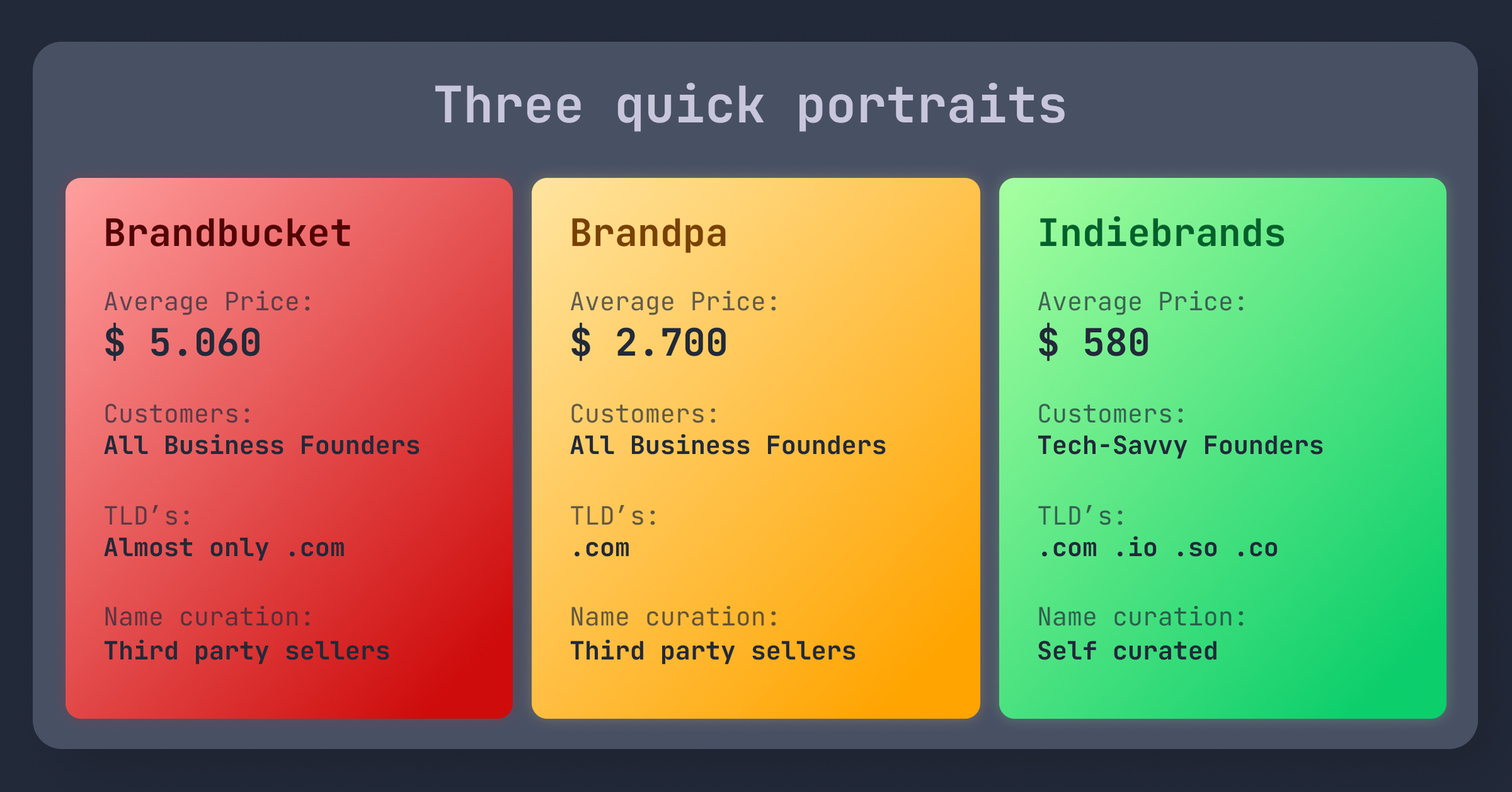
Pricing
Let's kick things off with pricing since in every comparison of similar businesses pricing plays a huge role. I've analysed the prices of a ton of names of Brandbucket, Brandpa & Indiebrands.
Btw: All of the data for every graphic can be found in this google sheet.
Here are the average prices:
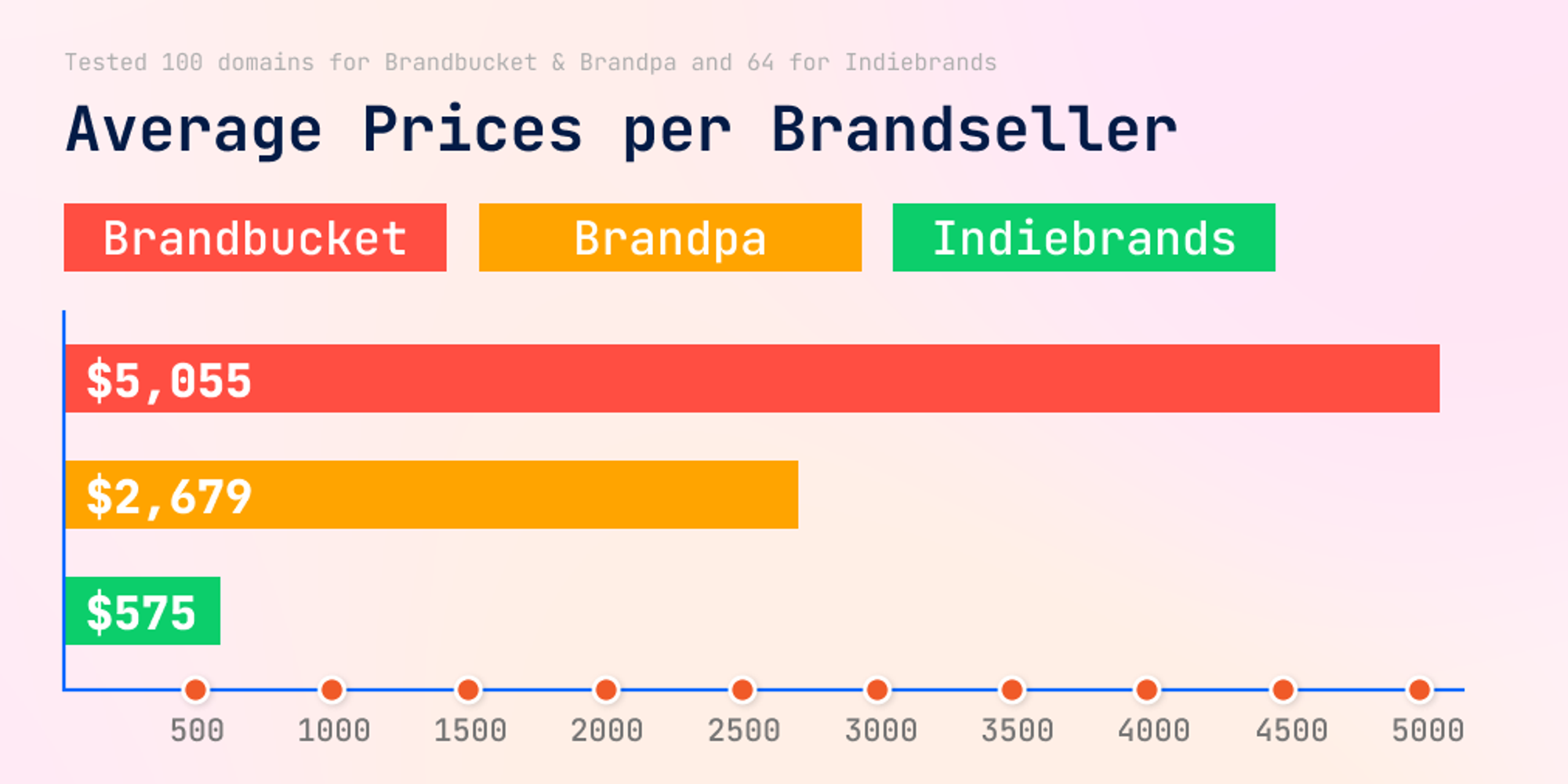
This already paints a clear picture. Brandbucket is clearly the most expensive, followed by Brandpa with about 50% of the price and then us, Indiebrands, costing about a tenth of Brandbuckets average.
Besides the average price, it's interesting to look at how the products are distributed across price ranges. I've started with 2x $500 steps followed by 3x $1.000 and 3x $2.000 steps.
Here's the pricing distribution:
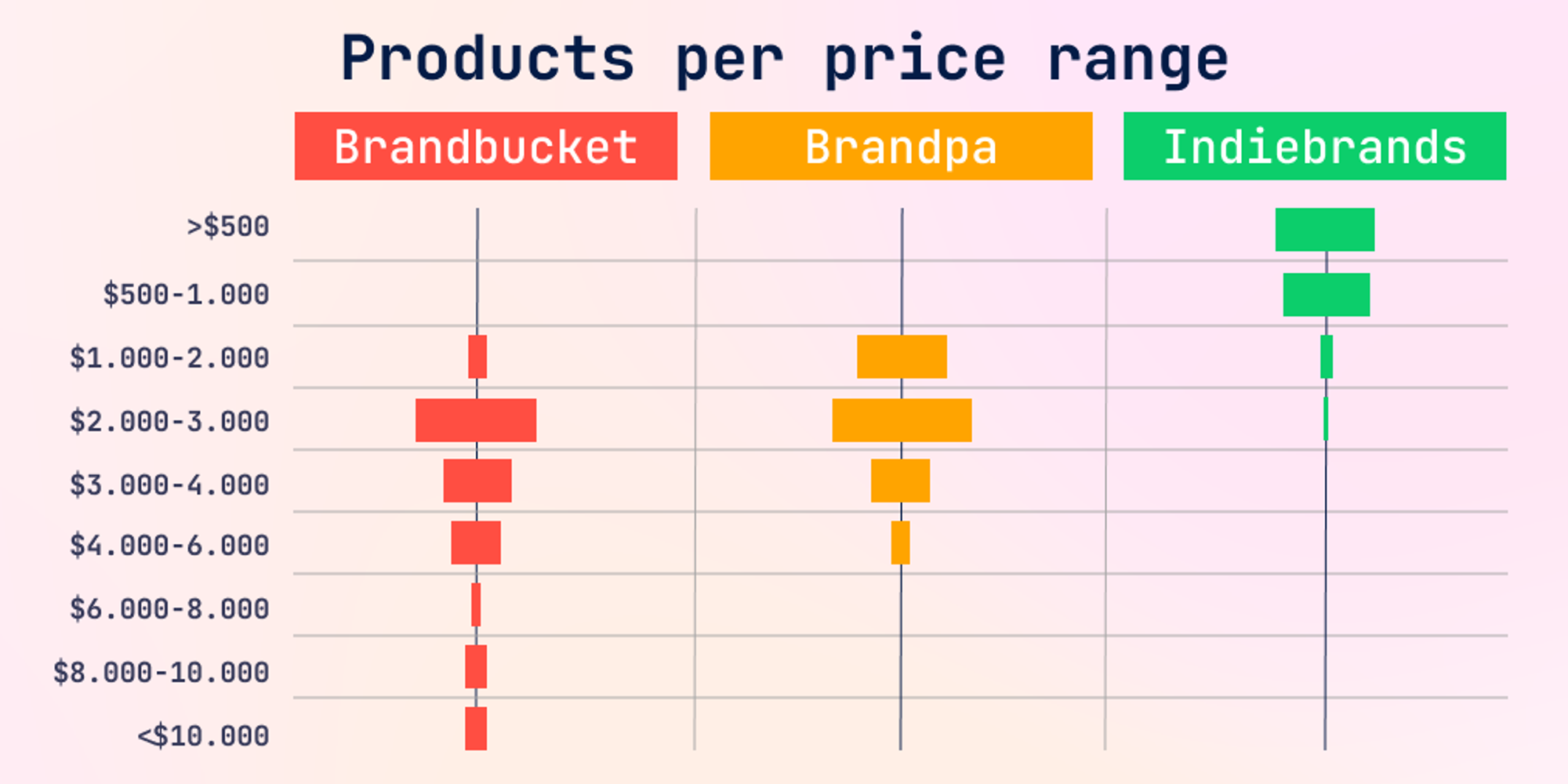
But what leads to those prices? A reasonable thought would be, that those prices are dependent on the quality of the name and logo. But is that the case? Let’s compare.
Let's start with the names. To get a comparable statistic we're going to measure average prices based on the length + TLD of a given name.
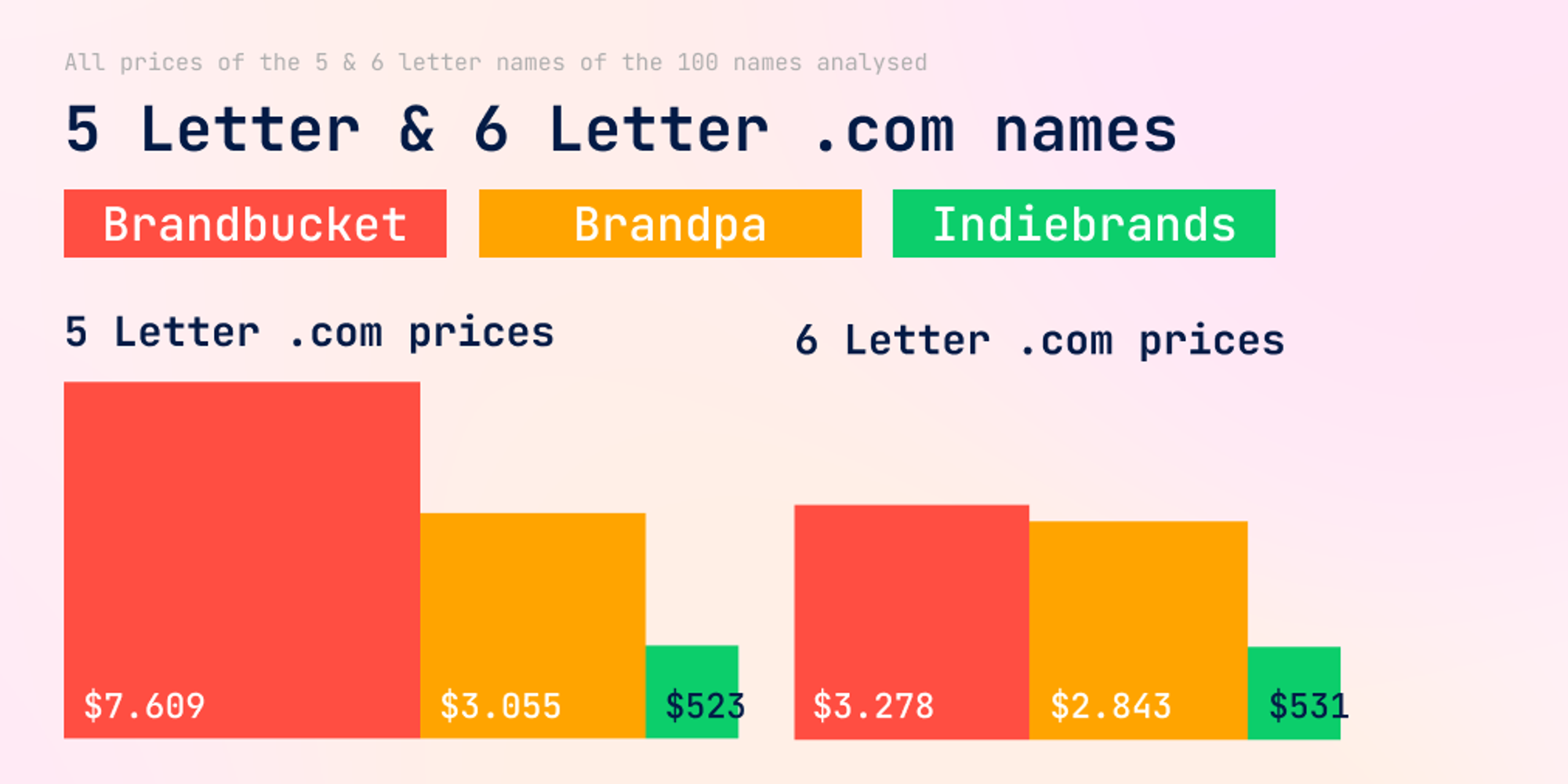
As the statistic shows the same pricing pattern also applies to similar products. With Brandbucket clearly being the most expensive, followed by Brandpa while we're the cheapest with Indiebrands.
If the name doesn't impact the price, does the Logo? Or maybe it's the business model?
We're going to look at both of that, but let's start with the business model:
Why Brandbuckets & Brandpas Business-model enables high prices.
The main difference between prices like Brandbucket & Brandpa vs Indiebrands lies in the different Business models. That’s a bold thesis I’m making here, so hear me out:
Brandbucket & Brandpa are marketplaces for third-party sellers. Domain-traders can offer their domains on those websites and try to find potential buyers. Brandbucket & Brandpa take a cut of the domains sold and sellers could make a profit off of their audience. Something that sounds like a win-win situation. But is that the case?
Usually, businesses that have an inventory need to sell a certain percentage of it to break even and be able to make a profit. In this case, it’s different since Brandbucket & Brandpa don’t have Inventory costs. This will lead to a sweet spot between pricing, products sold & profit.
Take a look at this profit example:
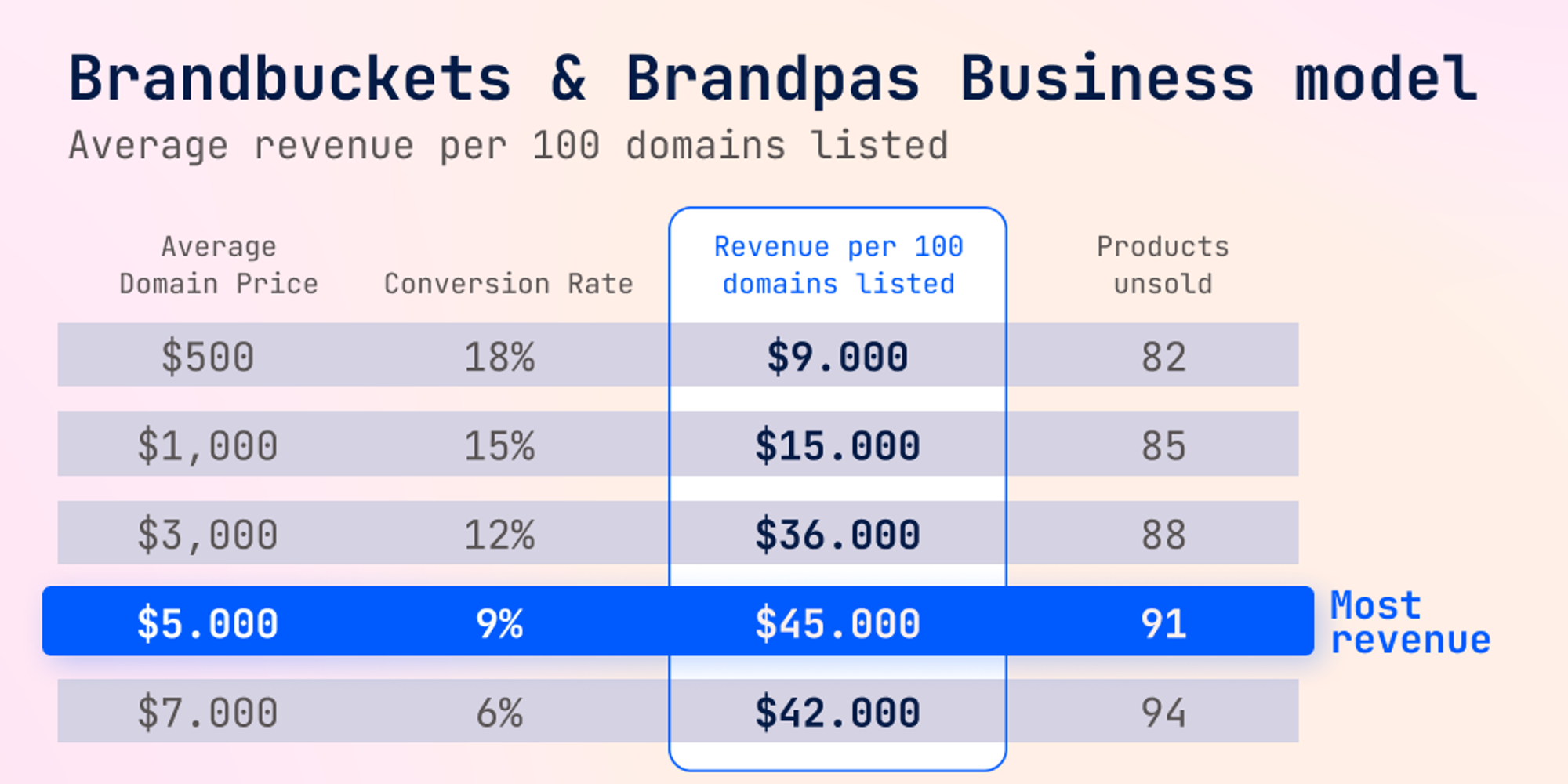
If their revenue doesn't correlate with their efficiency in selling their inventory what does that mean for domain traders?
Even though domain traders can change the prices of their listings a price is suggested. Which usually it's accepted & unchanged.
This leads to a business model where Brandbucket & Brandpa only need to make sure that the number of new domains listed by domain-traders exceeds the number of domains that were taken down + domains sold.
Effectively making it a no-risk business for Brandbucket & Brandpa. All risk is held by the domain traders.
How is Indiebrands different?
First, Indiebrands isn't a marketplace. Which means the name curation is not in the hands of third party sellers but in our own. This results in fewer names but with higher quality.
Second, Brandbucket & Brandpa are accepting & listing names of all types of businesses while Indiebrands is focusing on names for the tech-savvy founders. This approach especially helps our customers finding the right name faster by limiting the options to better suiting names.
And as seen in the example above Brandbucket & Brandpa have no financial interest in only providing qualitative names. They make a profit wether or not all their listed names are great. Likely even the opposite is true, because if more domain-traders list their names it means they have more potential affiliates, which results in their business being known better. This doesn't apply to Indiebrands. Our customers know us because of the quality standard we set for ourselves. Which is to only pick names that are brandable & memorable.
Quality of Logos
How can we determine the quality of logos? Isn't it only a personal preference? To a certain degree that's the case. But there clearly are certain attributes a logo needs. It has to be simple enough to be quickly recognisable, convey a certain feeling and nowadays it also needs to work in the digital environment.
First of all logos are visuals; so that's how we're going to start this comparison. I've picked 4 random Logos of the 5 & 6 letter names we've analysed and compared them here.
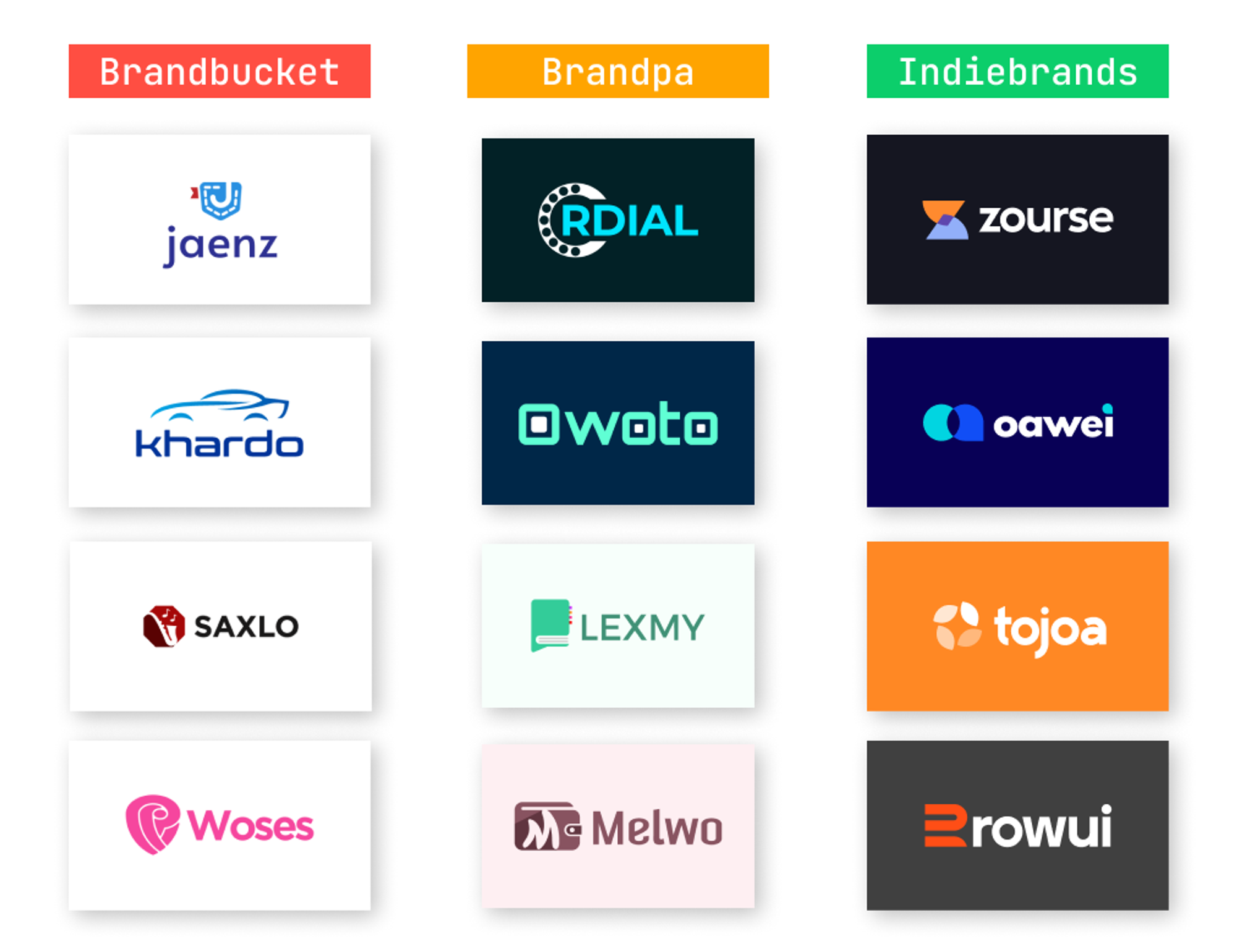
Brandbucket
Brandbucket Designers: Brandbucket claims to have a community of designers. Considering the amount of names the have listed (152.000) it's pretty safe to assume that their "community of designers" are outsourced jobs to third party designers that are willing to work for a tiny budget.
Logo-Identity: Considering the sheer amount of logos Brandbucket has to produce daily, it isn't suprising that the quality of the logos isn't number one priority. Considering the listing fee of $9 dollars on Brandbucket, the potential budget for a logo is diminishingly small. Which leads to tons of bad quality logos. Meaning that they have to much detail, aren't evenly spaced out and won't work in smaller sizes or greyscale. This makes them unsuitable for building a memorable brand-experience.
Brandpa
Brandpa Designers: Every person that has designed some logos before, commercial or noncommercial, can become a Brandpa designer. This works simply by sending them an e-mail with example work, education is not a necessity. They pay starts at $ 4.50 per logo.
Logo-Identity: Brandpa has no clean design language across their logos. By having such a diverse community of designers I could find some logos I found great. But, similar to Brandbucket, most of them turned out too detailed and unbalanced.
Take a look at LEXMY for example. It has so many little details, one can barely notice the grey lines that should indicate book pages. This is a result of the flat hiring process & the fact that they're giving away the approval of quality to the domain seller rather than a branding expert.
Indiebrands
Indiebrands Designers: Most Indiebrands logos are made by in-house designers & some are outsourced to selected designers. Every logo that Indiebrands outsources is approved for quality by an in-house designer & reworked if needed before it is published.
Logo-Identity: While Brandbucket & Brandpa have a high percentage of descriptive logos, Indiebrands focuses more on brandable logos. If you want to build a great brand it’s more important that your logo is memorable & conveys a certain feeling, rather than being complex & descriptive.
We also address tech-savvy audiences. That’s why we’re working on delivering logos suiting the design language in this field. This means going for simplistic logos that work well in a digital environment. Therefore many of our logos are shaped to easily fit an app-icon or a favicon. And besides, that Indiebrands delivers them both for light & dark backgrounds since that’s a requirement for many app/web designs.
What’s the right place for you to get your new brand?
If you’ve read through this article, you’ve seen the strengths & weaknesses of the different brands Webpages.
While Brandbucket & Brandpa have a huge amount of names in “their” portfolio, many of them have unfavorable logo designs & come at high average prices. They offer names for all types of businesses, which can be an advantage but can also lead to a very long search to find the right name.
Indiebrands on the other hand has a comparably small portfolio. Instead of trying to increase it too much, we’re focusing on finding quality names. Those names have a clear type that’s for a specific niche of tech-savvy founders.
Pick what’s right for you.